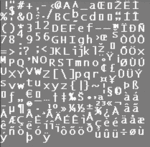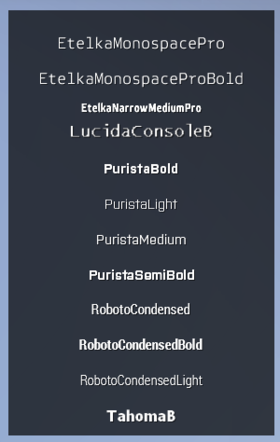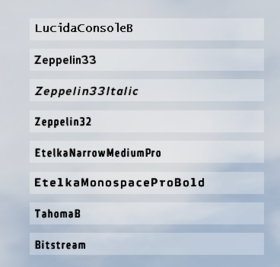FXY File Format
Introduction
The OFP and Armed Assault engines use a limited set of bit mapped fonts developed by Bohemia Interactive for the engine. They are bitmaps and each glyph within is treated as a texture.
A character set (such as Ascii) is a series of 'glyphs' (characters) where any one of these characters is always identified by the same index value. For example the letter A is always hex 41 and so on. Regardless of the font set employed, the character set within it, is set-in-concrete. Hex 41 always renders a glyph that 'looks like' the letter A. Be it bold, italic, or fills the entire screen, it is the letter 'A'.
The character set for all BI fonts in OFP is different for each language version. For Western languages it approximates US-Ascii codepage 437. In ArmA Unicode is used for fonts.
A font set is a collection of displayable characters (termed glyphs) that have a common appearance. E.g all glyphs in THIS set are bold, or all the glyphs are italic, all the glyphs are Times Roman (seriffed).
Individual font sets exist for Tahoma, Garamond, and so on.
The glyphs within these sets, are contained in .paa files. Generally, the entire font set = one, paa file.
And, because these are bitmapped fonts, eg fixed dimensions, non-scaleable, there are unique font sets, for, unique sizes.
For example, in Resistance engine, the popular Tahoma font is in three different font sets. 24 point, 36 point, 48 point.
A 'point' approximates 1/72th of an inch. Thus the Tahoma fonts available (for Resistance) are approximately a third, a half, and two thirds of an inch tall when displayed.
Description
An fxy file is the 'character set' index. It is, the codepage.
An fxy file is implicitly associated with one or more paa files within the same folder. The fxy file is the header entry for these files, it describes the position in the paa file and the size to be rendered on screen, for a 'glyph'.
Association of files between fxy and paa is implicit. The CourierNewB64.fxy is implicitly associated with the CourierNewB64-xx.paa file(s). xx indicating one of several CourierNewB64 paa's.
Legend
see Generic FileFormat Data Types.
Struct
Fxy
{
bytes ArmaSignature[8]; // ARMA ONLY
FxyEntry Entry1;
(...)
FxyEntry EntryLast;
}
ArmaSignature
ArmaSignature
{
char Magic[4]; //"BIFo"
ulong Version; // 0x101
}
FxyEntry
FxyEntry
{
ushort CharCode; // '''0x21''' = 'A' <<< see note
ushort PaaFileNumber; // 01
ushort X,Y; // Offset (in pixels) in the paa file, to the Top-left of this glyph.
ushort Width,Height; // area (number of) pixels used from the paa file for this glyph.
ushort KerningWidth; // ARMA only. Width used to determine this character spacing
};
Apart from the ARMA header (in Arma fxy files only), the fxy is a contiguous series of 12 byte (ofp) or 14 byte (Arma) entries.
CharCode
OFP uses a USASCII character set. Arma uses Unicode.
The first 256 unicodes ARE us-ascii. For this reason, the first 32 (x20) glyphs in EITHER character set, are control characters, never intended for display, and not included in the paa file(s) nor the fxy header. For that reason, in all circumstances, *the* displayed character is charcode+x20. Thus
'Actual Character' = charcode+x20;
Charcode x21 = index-entry =x21 = character x20+x21 = 0x41 = Glyph 'A'.
This is a constant, irrespective of the number of fxy tables (fonts) now or in the future. Charcode x21 can only ever be glyph 'A' (rendered in whatever style and size the font wants to render it)
- For OFP, there are 224 entries in any fxy table. (which therefore covers the 256 (224+32) possible us ascii 'characters'.
- ArmA fxy's have 448 character entries + 16 specials, as each font supports both Western European, Eastern European and Cyrillic character sets.
- Bearing in mind that basic 16 bit Unicode can display 65,000 glyphs, standard Arma fonts only use (and are only capable of displaying) a small selection:
- x20...17F Us Ascii + (most) European Languages
- 400...45F Cyrillic
- 2010...201F Special chars. unknown how they work.
You could extend this range in custom fonts of course to whatever you need from 16bit Unicode.
Note that index entries happen to be linear sequential. The nth index entry is also CharCode n. Which way, the engine actually accesses this table for character 'n' is up to the engine.
PaaFileNumber
-number of texture file: This is simply a convenience to allow large fonts to be spread across several paa's. For example if font name is "CourierNewB64":
- The fxy file is CourierNewB64.fxy
- The first texture file is CourierNewB64-01.paa
- The second texture file is CourierNewB64-02.paa
- etc.
Order of glyphs is entirely random in the sense that binarising these files uses a 'best fit' method to squeeze as much content into that file. Not perfect, but not badly done either.
Usage
This example uses the new font name in a Description.ext:
class RscText
{
type = CT_STATIC;
idc = -1;
style = ST_LEFT;
colorBackground[] = {0, 0, 0, 0};
colorText[] = {1, 1, 1, 1};
font = Bitstream;
sizeEx = 0.04;
};
Paa Content
Resistance
.paa files used for the font must be in 8080 format: (Alpha luminosity)
- 8bit - Brightness (all with 255 value - "white")
- 8bit - Alpha (255 for character, 0 for space)
ArmA
Arma Glyph files (paa) are formatted in DXT5 compressed textures. Using the TAGG labelling, they must additionally specify
Avg Color: any Max Color: always FFFFFFFF AlphaFlag: 1
Available Fonts
Arma 3
These fonts can be found in CfgFontFamilies:
- Caveat
- EtelkaMonospacePro
- EtelkaMonospaceProBold
- EtelkaNarrowMediumPro
- LCD14
- LucidaConsoleB
- PuristaBold
- PuristaLight
- PuristaMedium
- PuristaSemibold
- RobotoCondensed
- RobotoCondensedBold
- RobotoCondensedLight
- TahomaB
Arma 2
- LucidaConsoleB
- Zeppelin33
- Zeppelin33Italic
- Zeppelin32
- EtelkaNarrowMediumPro
- Bitstream
- TahomaB
- EtelkaMonospaceProBold
Armed Assault
- Arial Bold 7 -> 24 pt
- BitStream
- Versans bold 7 -> 20, 22, 28 pt
- Zeppelin32 12 -> 20, 22, 28 pt
- Zeppelin33 12 -> 20, 22, 28 pt
- Zeppelin33 italic 12 -> 20, 22, 28pt
Operation Flashpoint: Elite
- Arial Bold 7, 8, 10, 11, 12 pt
- Arial Italic 9, 13, 18, 48 pt
- CourierNew 9pt
- Hel67-CM 10, 11 pt
- HelvCondLight 8, 9, 10 pt
- Helvetica-Narrow 11pt
- Helvetica-Narrow Bold 8pt
- Helvetica37-CondensedThin bold 10pt
- Helvetica57-Condensed 10, 13, 16pt
- Helvetica57-Condensed 9, 13, 14 pt Bold
- Helvetica67-Condensed 9, 10, 11pt Medium
- HelveticaNarrow 10, 11pt
- HelveticaNarrow bold 10, 13, 18, 22pt
- HelveticaNeue 10 -> 14, 22pt
- HelveticaNeue Bold 22pt
- LucidaConsole Bold 8, 11pt
- MSS Bold 9pt
- System 10pt
- System Bold 10pt
- Tahoma 10, 11, 12, 14, 16, 20, 21pt
- Tahoma bold 5, 6, 7, 9 -> 14, 16, 20, 21pt
- Tahoma Bold Italic 12pt
Operation Flashpoint
- AudreysHand Italic 48pt
- AudreysHand Bold 48pt
- CourierNew Bold 64pt
- Garamond 64pt
- Steelfish bold 64, 128pt
- SteelfishCE bold 64 pt
- Tahoma bold 24, 36, 48pt


